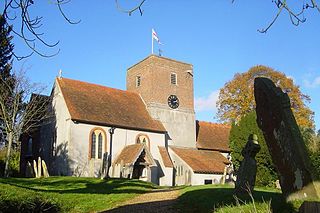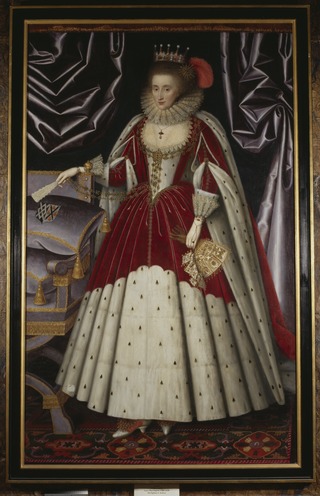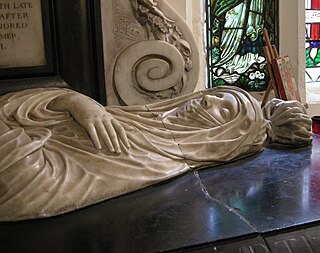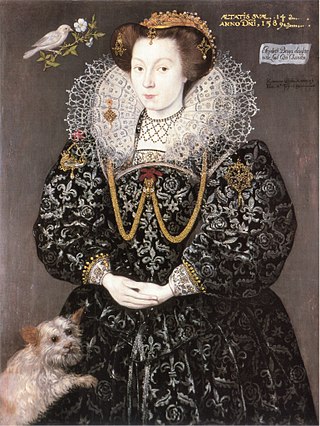Related Research Articles

Sir Bulstrode Whitelocke was an English lawyer, writer, parliamentarian and Lord Keeper of the Great Seal of England.

Sir James Whitelocke SL was an English judge and politician who sat in the House of Commons between 1610 and 1622.

Isaac Oliver or Olivier was an English portrait miniature painter.

Upton Grey is a village and civil parish in Hampshire, England.

Lucy Russell, Countess of Bedford was a major aristocratic patron of the arts and literature in the Elizabethan and Jacobean eras, the primary non-royal performer in contemporary court masques, a letter-writer, and a poet. She was an adventurer (shareholder) in the Somers Isles Company, investing in Bermuda, where Harrington Sound is named after her.

Nicholas Wadham (1531–1609) of Merryfield in the parish of Ilton, Somerset, and Edge in the parish of Branscombe, Devon, was a posthumous co-founder of Wadham College, Oxford, with his wife Dorothy Wadham who, outliving him, saw the project through to completion in her late old age. He was Sheriff of Somerset in 1585.

Dorothy Wadham was an English landowner and the founder of Wadham College, Oxford, one of the constituent colleges of the University of Oxford. Wadham was the first woman who was not a member of the royal family or titled aristocracy to found a college at Oxford or Cambridge. Her husband was Nicholas Wadham (1531-1609) of Merryfield in the parish of Ilton, Somerset and of Edge in the parish of Branscombe, Devon.

Lady Elizabeth Danvers née Neville, later Lady Elizabeth Carey by remarriage (1545/50–1630) was an English noblewoman. She was the mother of Sir Charles Danvers, executed in 1601 for his part in the rebellion of Robert Devereux, 2nd Earl of Essex, and of Sir John Danvers, one of the commissioners who tried King Charles I and signed the King's death warrant.
Cecily Bulstrode was a courtier and subject of poetry. She was the daughter of Edward Bulstrode (1550–1595) and Cecily Croke; she was a cousin of Lucy Russell, Countess of Bedford, in whose household she was a member in 1605. Two years later, she served as a Gentlewoman of the Bedchamber to Anne of Denmark.
Unton Croke was an English judge and politician who sat in the House of Commons in 1628 and 1640. He supported the Parliamentarian cause during the English Civil War.

Lady Elizabeth Berkeley, was an English courtier and patron of the arts.
George Garrett or Garrard was an English Member of Parliament.
Sir William Cornwallis of Brome was an English courtier and politician.

Sir John Eyre (1580–1639), initially of Great Chalfield Manor, Wiltshire and later of St. Giles-in-the-Fields, Middlesex was an English courtier, ambassador and Member of Parliament.

Elizabeth Brydges was a courtier and aristocrat, Maid of Honour to Elizabeth I, and victim of bigamy. She was a daughter of Giles Brydges, 3rd Baron Chandos, and Frances Clinton, who lived at Sudeley Castle.
Sir Edward Zouch of Woking was a courtier to English kings James and Charles I, a masque actor, and Knight Marshal of the King's Household.
Bridget Markham (1579–1609), was a courtier to Anne of Denmark and subject of poems.
Mary Middlemore was a Courtier and Maid of Honour to Anne of Denmark, subject of poems, and treasure hunter.
Dorothy Hastings was a courtier to Elizabeth I of England and Anne of Denmark

Anne Keilway was an English courtier.
References
- ↑ Frederic Madden, Collectanea Topographica Et Genealogica, vol. 5 (London, 1838), p. 213: George Lipscombe, The History and Antiquities of the County of Buckingham, vol. 4 (London, 1847), p. 475.
- ↑ Ruth Spalding The Improbable Puritan (Faber&Faber,London 1975).
- ↑ John Bruce, Liber Famelicus of Sir James Whitelocke (Camden Society, London, 1858), pp. 16-18, 25-6: Will of Sir John Croke, TNA PROB11/113/486.
- ↑ Arthur Collins, Jewels and Plate of Elizabeth I (London, 1955), pp. 14, 268.
- ↑ Ronald Lightbrown, 'Regalia', Arthur MacGregor, The Late King's Goods (London, 1989), 262–63.
- ↑ EYRE, Sir John (1580-1639), of Great Chalfield, Wilts.; later of St. Giles-in-the-Fields, Mdx. The History of Parliament . Retrieved 1 December 2017.
- ↑ John Bruce, Liber Famelicus of Sir James Whitelocke (Camden Society, London, 1858), pp. 16-18, 25-6.
- ↑ Jemma Field, 'The Wardrobe Goods of Anna of Denmark', Costume, 51:1 (March, 2017), p. 21, & supplement nos. 23, 333, 384.
- ↑ Christine Jackson, Courtier, Scholar, and Man of the Sword: Lord Herbert of Cherbury and His World (Oxford, 2021), pp. 91-92.
- ↑ James Lees-Milne, 'Two Portraits at Charlecote Park by William Larkin', The Burlington Magazine, vol. 94, No. 597 (Dec., 1952), pp. 352-6.
- ↑ Patricia Fumerton, 'Secret Arts: Elizabethan Miniatures and Sonnets', in Sephen Greenblatt, Representing the Renaissance (Berkeley, 1988), p. 124.
- ↑ Horace Walpole, The life of Edward Lord Herbert, of Cherbury. Written by himself (Edinburgh, 1809), pp. 134-149.
- ↑ HMC 5th Report: C. Griffith (London, 1876), p. 408.
- ↑ John Bruce, Liber Famelicus of Sir James Whitelocke (Camden Society, London, 1858), pp. 25-6.
- ↑ John Bruce, Liber Famelicus of Sir James Whitelocke (Camden Society, London, 1858), pp. 21, 26, 61.
- ↑ 'Parishes: Upton Grey', in A History of the County of Hampshire, vol. 3, ed. William Page (London, 1908), pp. 382-386. British History Online.
- ↑ 'Upton Grey', The Gentleman's Magazine, vol. 66 part 1 (London, 1796), pp. 15-16.